Mitumba
What does this Swahili word mean?
What does this Swahili word really mean?
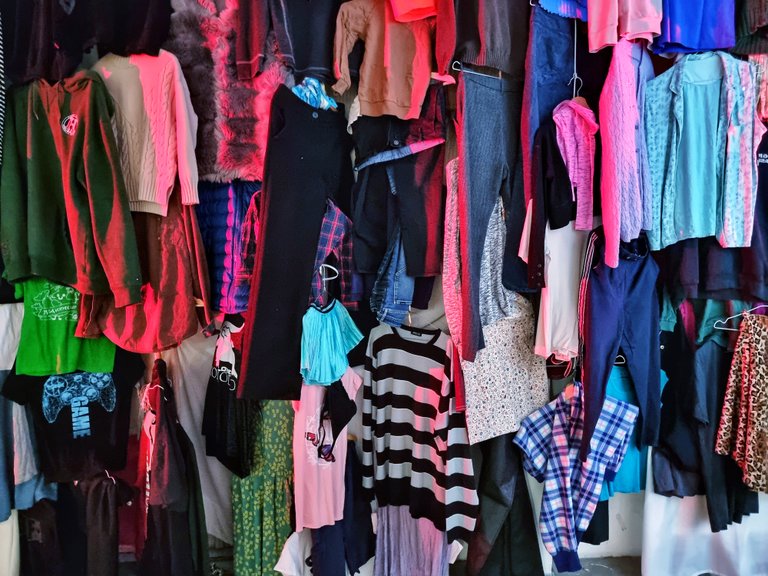
There were eight artists with very striking presentations, but I have decided to choose the ones to show you.
You can see the first three here.
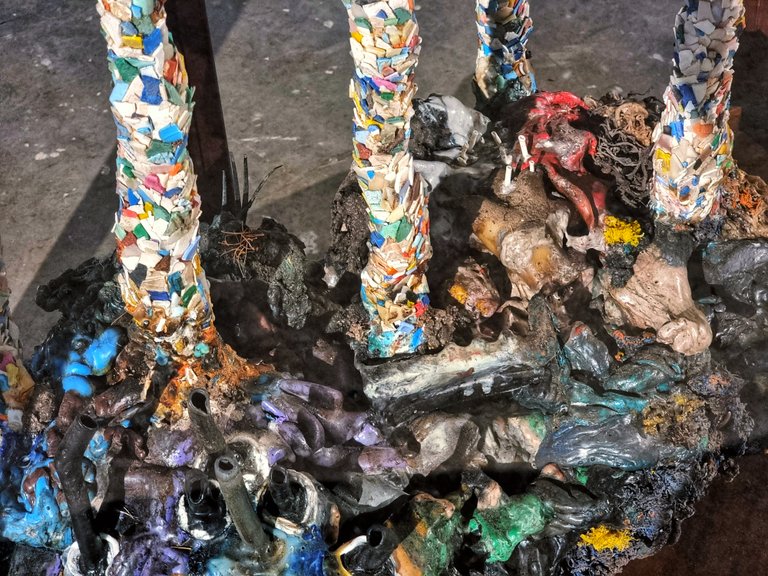
Palaeontological Plastic IV is the oldest art installation in Wasteland. My initial thought was, what did palaeontology and plastic have in common? But I was simply failing to look at the obvious.
The physical installation is a double entendre, just like the title. The art almost camouflages perfectly into non-existence to the subconscious mind. What I mean is, as I looked around Wasteland, I almost didn't notice it. Which is a very powerful metaphor to how blind modern consumerism and dependencies is to the accumulation of plastic.
It is shaped like a coral, and made end to end from plastic collected from oceans. It stands as a reminder of plastic in the oceans killing and taking over coral reefs.
Plastic has solidified itself as a must-have material in modern times, speaking in general terms, but its effects are deadly. Not only do they have incredibly high longevity, but there are now also studies that show microplastics inside the human body.
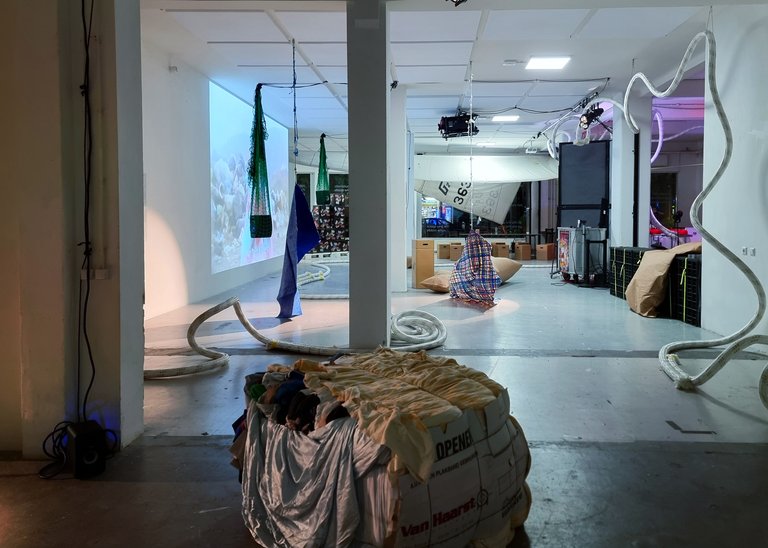
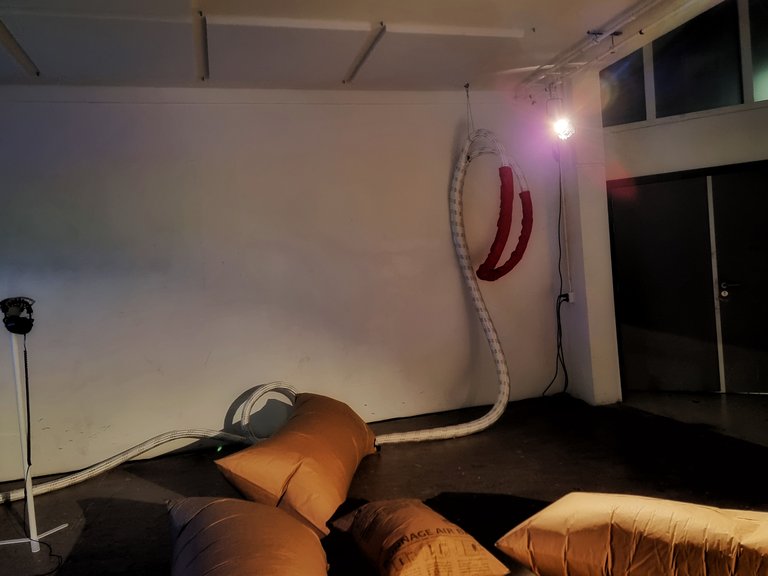
Throughout the venue, there were these alternative resting devices. The dunnage bags were used in place of beanbags. They are not the most comfortable thing in the world, but a creative way to create seating arrangements and stay true to the message of this exhibition.
The bails on the other hand were at first very confusing to me. Only later, when I stopped by the last installation would I realize what they meant.
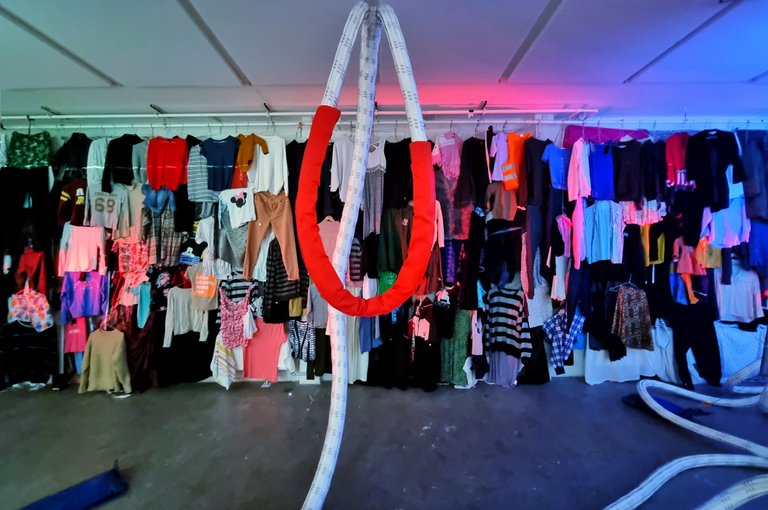
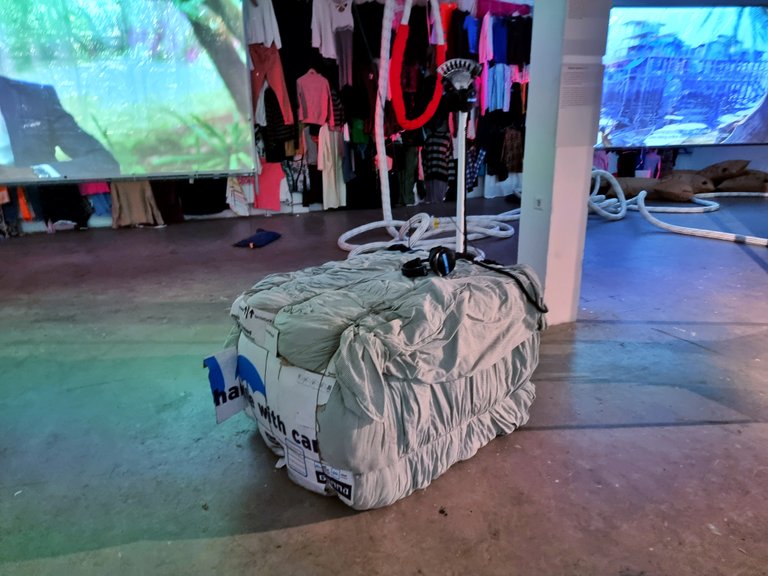
Across the hall, behind two large screens, was a wall covered with clothes.
What do they signify? Is it part of showing the vast amounts of items that get shipped in containers on ships? Or the vast amount of natural resources, pollution, or plastic used and created as byproducts?
I was not sure. I kept thinking about it while looking at a short documentary called Passig River 2030 - 6 Plus. A documentary where the artist used AI generated graphics to predict a world where tech, blockchain, big corp, AI, and all the other fancy words took a shot at preserving dieing nature digitally at the cost of digital colonisation.
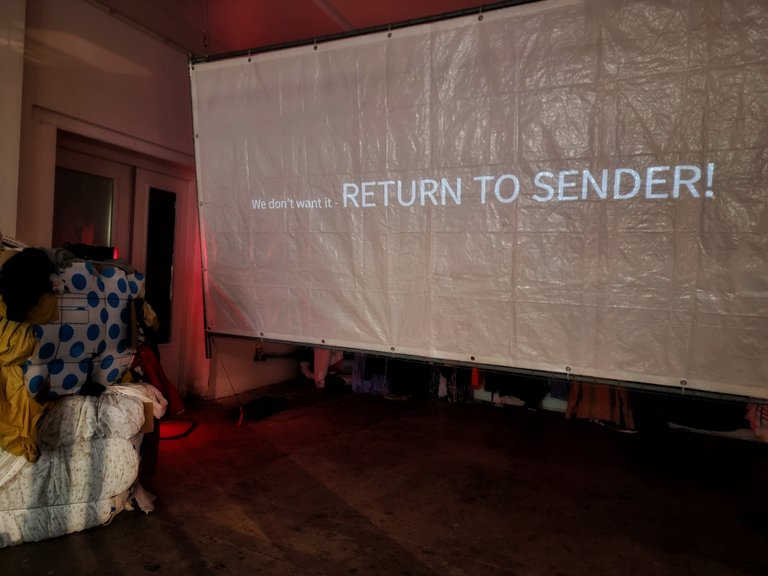
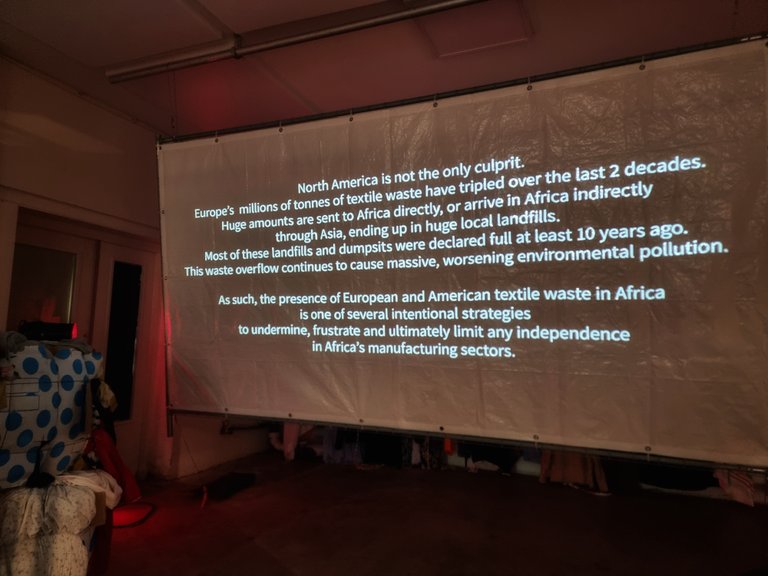
Mitumba
Here we are. The answer to all my puzzling questions. In fact, it brought the entire exhibition to a full circle for me. Albeit not related to some of the other installations at the exhibition, RETURN TO SENDER made it very clear that everything is related. In a sense, mindless corporate greed, blind capitalistic approach, and uneducated consumerism are the main culprits.
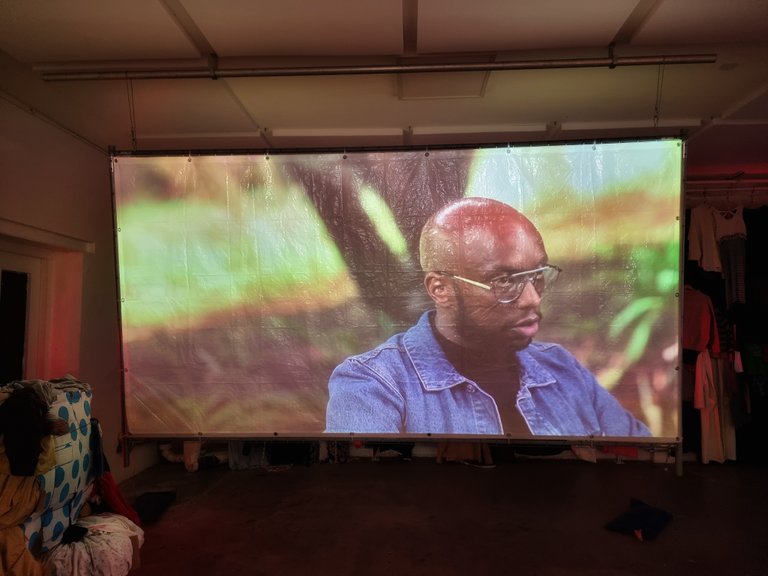
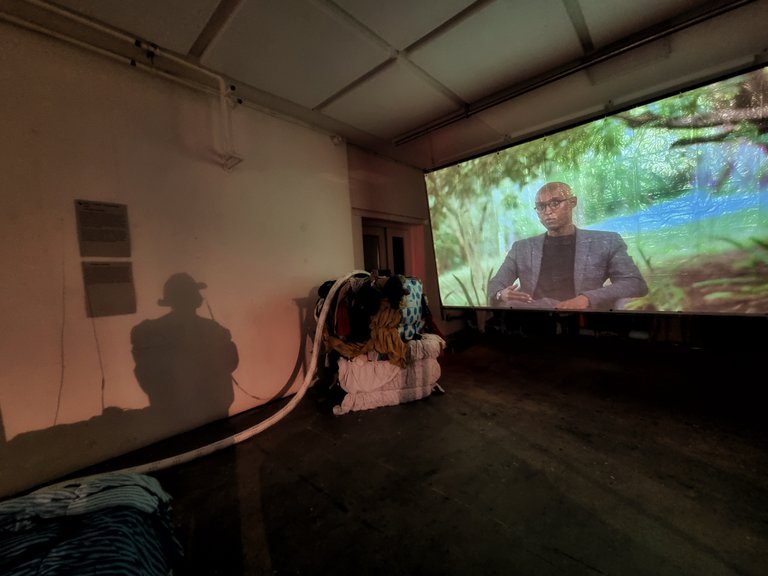
In my opinion, the cardinal sin of the capitalist world is that we try to pay and buy ourselves out of any and every problem.
The moment, a capitalist society is faced with a dire issue, the first reaction is to pour money into it and try to sift out a solution.
Tell me if I'm wrong.
Mitumba, is also a result of this approach.

Return to Sender is an eye opening short documentary. Mitumba means bundles in Swahili but has become synonymous to the problem created from bundles of unused, unusable, and extra clothes that come to Africa from the other parts of the world.
The problem is manyfold. I took a few days to research this problem and learn about it. Some of the most raw and striking information came to me by following the #mitumba tag on other social platforms.
While cheap clothing is in hugh demand due to the popularity of fast fashion, a lot of it goes wasted even if unused. Much of this is shipped to Africa, bound by governmental contracts, under the pretense that it would generate jobs for the poorer countries, create an industry, provide affordable clothing, as well as international financial contracts would be a takeaway let the African countries agree to take on these "waste" mitumba.
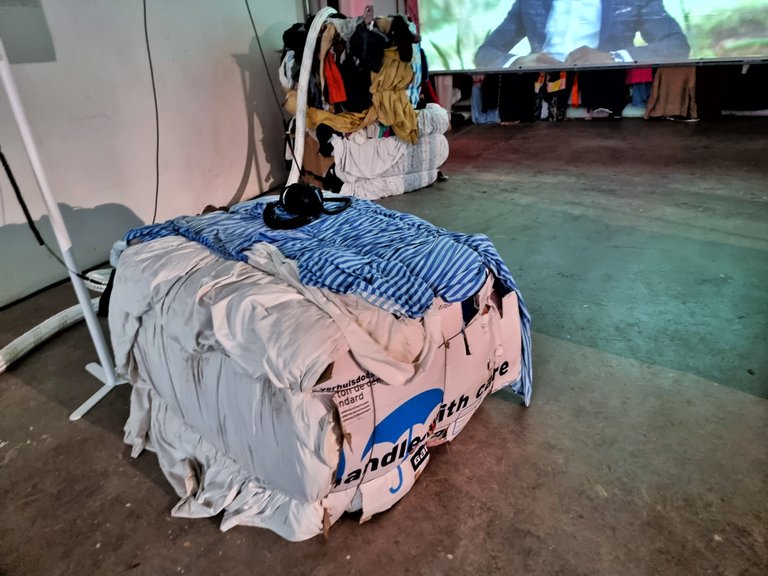
But Mitumba never worked out like it was planned, did it? Much like many of the other "green" plans that usually end up in the form of burning in the name of recycling, dumping grounds in the name of eco-friendly processing, and so much more.
"As long as the fruits don't rot in my garden."
Return to sender featured some of the most well-spoken and intelligent people to speak about this topic. The socio-economic crisis, the humanity factor, the freedom to wear good clothes and feel like a dignified person, the piling garbage, and the reality of destroyed industries and lost jobs in the name of creating one.

Affiliate links
Rising Star
Exode
Huobi
Appics
Splinterlands
Actifit
Binance
Ionomy
Cryptex
 N.F.A.
N.F.A.
Thanks team. Glad you liked it!
What an interesting exhibition! And you really did your homework as understanding and explaining what you see is not easy. Seeing what was exhibited is not a pleasant thing but I consider it a must, a wake-up call and this is the reason this initiative should go worldwide.
I spent the last ten minutes looking for a post I've read on Hive about the same topic. There was a similar exhibition in Athens but couldn't find the post. I'm going to try to find it tomorrow as I think you would like to read it.
Later Edit: found it! https://peakd.com/hive-155530/@orestistrips/walking-my-hometown-after-months-of-absence
The impact this fast fashion and other type of waste has on the environment is huge. Did you know that to dye one square meter of fabric 150L of water is used? Crazy!
Oh well, truth is bitter. If anything, this exhibition solidified my position on the debate of if it is an individual responsibility or a corporate responsibility. My answer is that its both. Corporate decision making is highly dependent on what brings profits to the stakeholders- which comes from individual consumers. So it has to be a hand in hand effort.
Thanks for digging out that post. Very cool to see that this message, in different forms, is making the rounds.
Don't go looking into how many gallons are used per jeans pant and per cotton shirt. GALLONS.
Do you have any idea if it's possible to watch this documentary online?
Fashion is such a con, on so many levels. From environment depletion, through slave work and overpriced branding ending with all these "help" programs with used clothes. As for "job-generation" isn't it exactly opposite? I heard about situations that local industries were killed by free shippings of used low quality goods from the "1st world".
Appearence of microplastics in geological sediment of current times is one of the key features that will allow future geologists distinguish layers from antropocene. And it was just few days ago when I visited my grandma's grave, it's that time in Poland we visit graveyards en masse and I had this reflection that plastic flowers, which are so popular have this sad and ironic symbolism there.
I tried searching online. Looks like documentary video is just a small part of a major movement. You could search "The Nest Collective- Return to Sender". Most of the websites I found only have info blogs but sadly I couldn't find the video.
That is an argument one of the speakers in the video mentioned. Mitumba and fast fashion has killed more jibs and dissolved more industries in Kenya and neighbouring countries, contrary to the pretense of creating them.
Rest in peace, Grandma.
I can see the irony in the plastic flowers.
It is very sad at the same time.
Nice place, they provide nice clothes too.
What? This comment is irrelevant.
every day we learn new things, first time I hear these terms Paleontological Plastic Every day I hear AI here and there I hope it is used as a tool to improve the work and not to replace the human being.
If AI replaces humans, and if so to what extent, is a major debate. It is a long conversation, and the effects of it are still unknown. However, that's besides the point of Wasteland exhibition.
Ugh. Waste. So much fucking stuff. We don't need all this stuff!!!
Precisely. All this wasteful "wants" create so many problems.
Unless we can make patchwork everything the new global trend and upcycle everything. But still all the plastic and packaging. Ugh.
Hello blind-spot!
It's nice to let you know that your article will take 6th place.
Your post is among 15 Bestszejq articles voted 7 days ago by the @hive-lu | King Lucoin Curator by
You receive 🎖 2.8 unique LUBEST tokens as a reward. You can support Lu world and your curator, then he and you will receive 10x more of the winning token. There is a buyout offer waiting for him on the stock exchange. All you need to do is reblog Daily Report 107 with your winnings.
Buy Lu on the Hive-Engine exchange | World of Lu created by szejq (Lucoin) and get paid. With 50 Lu in your wallet, you also become the curator of the @hive-lu which follows your upvote.
STOPor to resume write a wordSTART